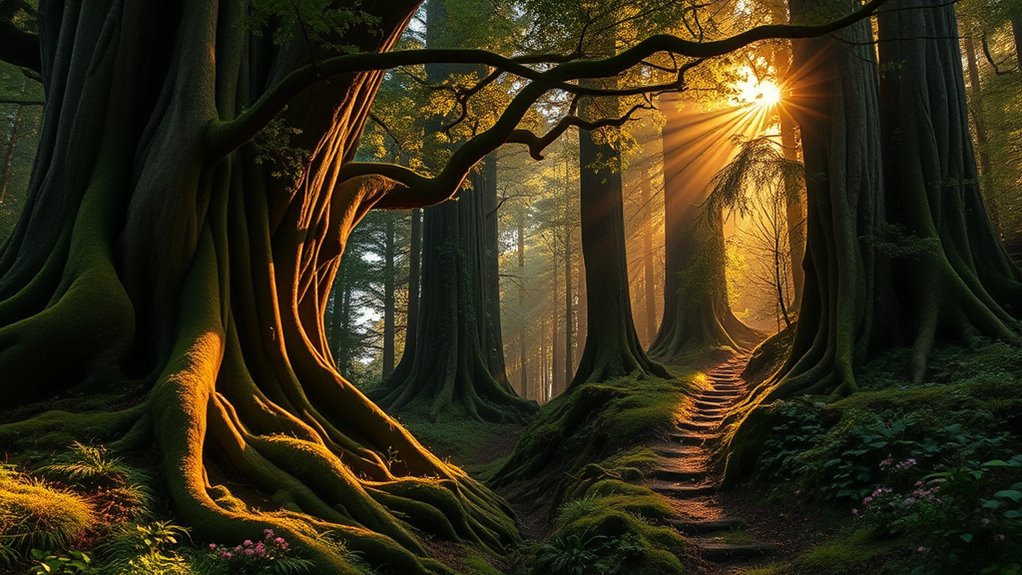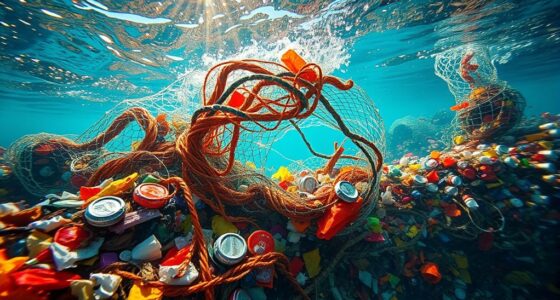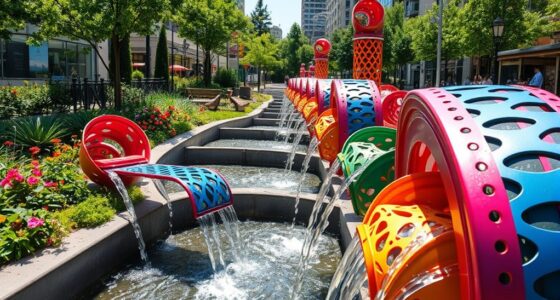Environmental storytelling in contemporary art uses physical spaces and visual elements to communicate urgent narratives about nature, climate, and ecological resilience. You’re invited to experience environments that highlight issues like pollution, decay, and sustainability through sculptures, ruins, and natural materials. These works evoke strong emotions and thoughtful reflection, inspiring you to contemplate your impact on the planet. Exploring these stories more deeply reveals how art can foster empathy, responsibility, and active engagement with ecological concerns.
Key Takeaways
- Contemporary environmental storytelling uses art to highlight ecological issues, fostering emotional and intellectual engagement with nature.
- Artists incorporate natural decay, urban ruins, and recycled materials to symbolize environmental fragility and resilience.
- Spatial design and symbolism in art create immersive narratives that provoke reflection on human impact and climate change.
- Environmental artworks transform abstract ecological concepts into tangible experiences, encouraging viewer participation and activism.
- These narratives aim to raise awareness, evoke empathy, and motivate action to address environmental challenges through visceral artistic expression.

Environmental storytelling is a powerful way to immerse players in a game’s world by using the surroundings themselves to convey history, mood, and narrative. This technique isn’t limited to video games; it extends into contemporary art, where artists craft environments that tell compelling stories about nature and humanity’s relationship with it. In today’s context, these narratives often highlight pressing issues like climate change and ecological activism, urging viewers to reflect on their role in the planet’s future. By embedding messages within physical spaces, artists create immersive experiences that evoke emotional responses and provoke action.
Environmental storytelling immerses us in art that reveals nature’s stories and urges ecological action.
When you step into these environments, you become part of a story that’s layered with meaning. For example, an installation might feature decaying natural elements juxtaposed with signs of human intervention—such as abandoned machinery or overgrown urban ruins. These settings serve as visual commentary on climate change’s destructive impact and the urgent need for ecological activism. The decay and chaos reflect environmental degradation, prompting you to contemplate how human choices accelerate these processes. Such artworks often challenge you to see the environment not as a distant concern but as an immediate, tangible narrative that demands your attention and participation.
Environmental storytelling through contemporary art often employs symbolism and spatial design to deepen its message. You might encounter sculptures made from recycled materials, highlighting the importance of sustainability and resourcefulness. The arrangement of these pieces can suggest a story of loss and hope—showing what’s been damaged and what can be saved through collective effort. Artists deliberately craft these environments to evoke feelings of fragility, resilience, and responsibility. As you move through these spaces, you’re encouraged to connect emotionally and intellectually with the stories they tell, fostering a deeper understanding of ecological issues and inspiring activism. Incorporating raw materials into artworks can emphasize the importance of sustainable resource use and conservation.
This approach also emphasizes the power of place in shaping narratives. You’re not just an observer but an active participant in the story. The environment becomes a stage where history, current crises, and future possibilities unfold. The visual language used in these artworks makes complex issues accessible and personal, breaking down barriers between scientific facts and emotional engagement. Through this, contemporary art becomes a platform for ecological activism—mobilizing viewers to recognize their influence and take action.
Ultimately, environmental storytelling in art aligns with the broader movement to address climate change by making environmental issues visceral and immediate. It transforms abstract concepts into tangible experiences, fostering empathy and motivating change. When you encounter these stories, you’re reminded that the environment isn’t just a backdrop but a crucial narrative intertwined with human existence—one that requires your awareness, voice, and activism.
Frequently Asked Questions
How Does Environmental Storytelling Influence Public Perception of Climate Change?
Environmental storytelling influences your perception of climate change by fostering public engagement and emotional resonance. When you experience compelling narratives in art, you’re more likely to connect personally with environmental issues, making them feel urgent and real. This emotional connection motivates you to care, share, and act. By shaping perceptions this way, storytelling becomes a powerful tool to inspire collective responsibility and drive meaningful change on climate issues.
What Are the Most Innovative Mediums Used in Environmental Narratives?
Imagine stepping into a living, breathing story—interactive installations and augmented reality are transforming environmental narratives into immersive journeys. You can walk through digital forests or witness melting glaciers in real-time, making climate change feel tangible. These mediums blend art and technology, pulling you into the narrative like never before. They’re pushing boundaries, turning passive viewers into active participants, and helping you connect deeply with nature’s fragile story.
How Do Cultural Differences Shape Environmental Storytelling Approaches?
You’ll find that cultural differences shape environmental storytelling approaches by influencing storytelling techniques and the focus of cultural narratives. In some cultures, storytelling emphasizes harmony with nature, using traditional methods like oral histories and visual art. In others, contemporary techniques like digital media or interactive installations highlight environmental issues. Recognizing these diverse storytelling techniques helps you understand how cultural narratives shape perceptions of nature and inspire action.
Can Environmental Art Provoke Policy Changes Effectively?
It’s no coincidence that environmental art can effectively provoke policy changes. As you engage in art activism, your work draws attention and inspires dialogue, potentially shaping policy advocacy. By creating emotionally compelling narratives, you connect viewers to environmental issues on a personal level, motivating them to support policy shifts. Your art becomes a powerful tool, bridging the gap between awareness and action, ultimately influencing policymakers and driving tangible environmental change.
What Are Emerging Trends in Environmental Storytelling for Future Generations?
You’ll notice emerging trends in environmental storytelling focus on integrating sustainable practices and digital engagement. You can expect more artists to use eco-friendly materials and tech like virtual reality, augmented reality, and interactive platforms to connect with future generations. These methods create immersive experiences that foster awareness and inspire action, making environmental narratives more accessible and impactful. Embracing these trends guarantees your message resonates across generations, encouraging sustainable behaviors and ecological stewardship.
Conclusion
As you explore these narratives of nature, remember they’re like windows opening to a world that’s both fragile and resilient. Through contemporary art, your perspective shifts, revealing the deep stories our environment whispers. By engaging with these stories, you become an essential part of the ongoing dialogue, helping to nurture and protect the very world that sustains us all. Let these artistic voices be the compass guiding you toward a more mindful, harmonious relationship with nature.









